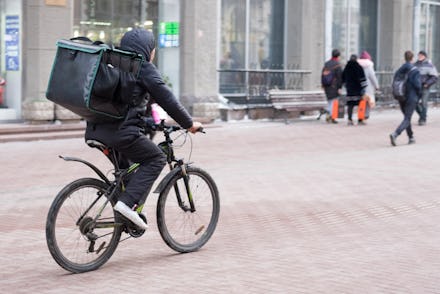How to make sure your food delivery person gets a good tip

Tipping is one of those things that is somehow both commonplace and confusing at the same time. In the United States, tipping is customary — at least when it comes to things like cab rides, restaurant service and food delivery — but how much to tip in those cases is a bit murkier. For food delivery in particular, there are actually more factors at play than most of us may realize; and they can all impact how much we tip.
How much should you tip for delivery in general?
When you’re dining in at a table-service restaurant, the tipping recommendation is usually in the range of 17 to 20 percent of your meal. When you’re getting food delivered, it’s a bit more transactional — the delivery person is bringing your food from point A to point B and then moving on — so Ted Rossman, CreditCards.com industry analyst said it’s generally okay to decrease the tip amount. But, keep in mind that according to Wait But Why, tips make up 30 to 70 percent of a delivery person’s salary, so it’s important to tip them sufficiently for the job they’re doing.
“When it comes to tipping those who deliver food, you can base your total tip on how much you order,” said etiquette and protocol consultant Melissa Leonard. “If you are ordering Italian or Chinese food for four to five people, I would recommend giving a flat rate — perhaps $5 to $8 when they hand you your food. If you are ordering a large amount of food that requires multiple trips to bring to your door, I suggest giving a larger sum such as $10 to $15.”
You can also aim for a percentage — Rossman recommended 10 to 15 percent — but don’t tip less than $2 or $3 in any case. “If you have a small order and doing 10 or 15 percent would be less than that, I think you should at least give two or three bucks,” he said.
Should you bump it up in bad weather?
If a restaurant is open in inclement weather, don’t be deterred from ordering — as Thomas P. Farley, New York-based etiquette consultant known as Mister Manners previously told Mic, that decision ultimately keeps the delivery people from making money. That said, consider the conditions they’re dealing with — whether it’s driving on slippery roads or walking and biking through the elements — and bump up their tip accordingly. “I always like to tip those who come out in awful weather, especially if the weather is keeping us from going out to pick up the food,” Leonard said. “Snow, monsoon rains or stormy windy conditions may deserve an extra few dollars, as you know the delivery person is getting wet going in and out of car. Showing gratitude through tips is a nice way to say, ‘Thanks for coming out in this horrendous weather!’”
She recommended adding $2 to $5 on top of your usual tip; but if you can spare more, “give what you feel is due.”
What about the “delivery fee” that’s already included?
Typically when you order in, restaurants and sites like Grubhub include a “delivery fee” on top of your meal cost — but don’t get that confused with tips. “In many cases, the delivery fee goes entirely to the company, or sometimes it goes partly to the company and partly to the driver,” Rossman said. “But I definitely would not assume the driver is getting all of it — I would say rarely is the driver getting all of that delivery fee.” Bottom line: You may be paying extra for the convenience of delivery, but don’t consider that fee part of your tip.
And, Leonard added, “it should be noted that a ‘minimum delivery amount’ to have your food delivered has nothing to do with the driver. [They] should be tipped just the same as if there is no delivery minimum.”
Does the delivery person get the whole tip?
Delivery fees aside, it’s possible your delivery person isn’t even getting the full tip you add to your order. For example, NBC News reported in February 2019 that both Instacart and Doordash came under fire for policies that incorporated customers’ tips into the minimum delivery rate the companies guaranteed drivers. “Basically, tips were making up some of the base wage and then if there weren’t enough tips...Instacart and Doordash would kick in,” Rossman said. “But that was definitely an unfortunate thing for the drivers, because money the customers I’m sure thought was going to go to these drivers as an extra was really just going to the base.” (Instacart updated its policy in the wake of the backlash, The New York Times reported.)
While these are just two examples, they’re a reminder that there may be a lot going on behind the scenes that we as customers aren’t privy to — including where our tips go. If you’re not sure about a service you’re using, Rossman recommended doing some online searches. “A lot of delivery drivers are active on social media, including forums like Reddit, and there [are] lots of blogs out there that talk about what it is really like to drive for Uber or deliver for Grubhub, [for example],” he said. “A lot of these things with the sharing economy and apps are still so new that we are still all figuring them out together.”
Whatever information you can find, though, can be used to inform how much you tip — and if you want to work around those potential policies, you can always give cash. Regardless, if you can afford it, it never hurts to add a little extra to say thanks to the person bringing you food while you sit comfortably at home.